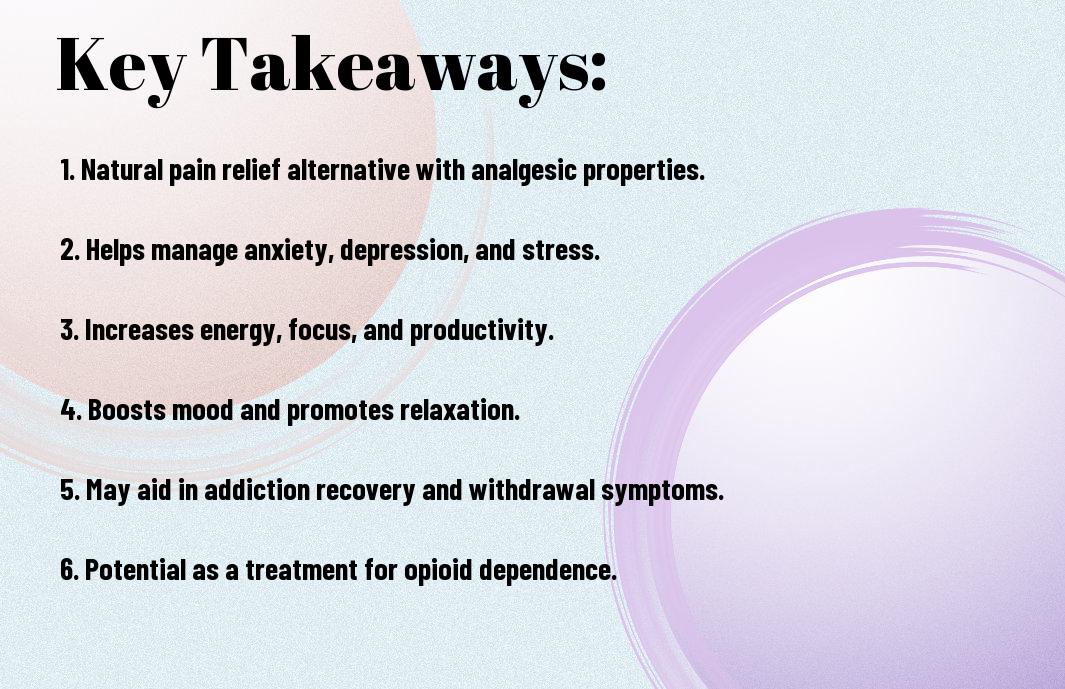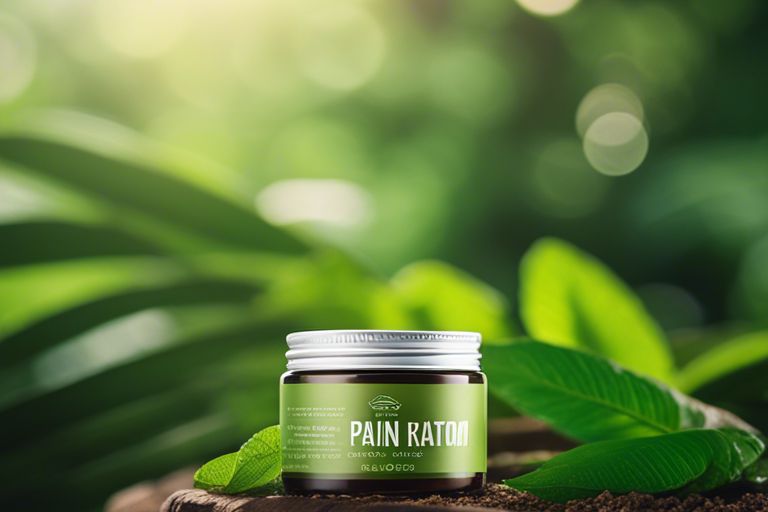Uses of kratom range from pain relief to energy boost and even mood enhancement. This Southeast Asian herb provides natural relief for a variety of ailments, making it a popular choice for those seeking alternative remedies. It is crucial to understand the proper dosage and potential risks associated with kratom to fully reap its benefits.
Key Takeaways:
- Kratom is a versatile plant: Kratom, also known as Mitragyna speciosa, is a tropical evergreen tree native to Southeast Asia. It belongs to the coffee family and has been used for centuries for its various medicinal properties.
- Potential benefits of kratom: Kratom is gaining popularity for its potential benefits, such as pain relief, mood enhancement, and increased energy levels. It is also used to alleviate symptoms of anxiety, depression, and opioid withdrawal.
- Varied forms of consumption: Kratom can be consumed in various forms, including capsules, extracts, powders, and teas. The appropriate dosage and method of consumption vary based on individual preferences and desired effects.

History and Origin of Kratom
The Health Benefits of Kratom have been recognized for centuries by Southeast Asian communities where the kratom plant grows abundantly. Indigenous people in countries like Thailand, Malaysia, and Indonesia have been using kratom for various purposes, including pain relief, energy boost, and as a traditional medicine for ailments.
Traditional Use in Southeast Asia
Traditional use of kratom in Southeast Asia involves chewing the leaves or brewing them into a tea for medicinal purposes. Kratom has been a part of cultural and religious practices in the region for generations. It is known for its stimulating effects at low doses and sedative properties at higher doses, making it a versatile herb with a wide range of applications.
Early Recordings of Kratom Consumption
Any early recordings of kratom consumption date back to the 19th century, where European explorers documented the use of kratom by indigenous tribes in Southeast Asia. The plant’s popularity grew among laborers who used it to combat fatigue and perform better while working. Another key point is that the recreational use of kratom has also been noted in traditional ceremonies and social gatherings in these regions.
As kratom gains popularity in Western countries, it is vital to understand its cultural significance and traditional uses in its countries of origin. While kratom has many potential health benefits, it is crucial to use it responsibly and be aware of potential risks associated with its consumption. Stay tuned for more insights on the uses and benefits of kratom in our upcoming blog posts.
Chemical Composition and Mechanism
Alkaloids and Their Effects
Any discussion of kratom’s benefits must begin with its chemical composition. Kratom contains over 40 different alkaloids, with two primary active compounds: mitragynine and 7-hydroxymitragynine. These compounds are partial agonists of the mu-opioid receptors and also interact with other neurotransmitter systems in the brain, leading to a diverse range of effects.
How Kratom Interacts with the Body
To understand the benefits of kratom, it’s crucial to explore how this plant interacts with the body. Kratom’s alkaloids bind to opioid receptors in the brain, producing effects similar to opioids but with a lower risk of respiratory depression. This unique mechanism of action is what sets kratom apart from traditional opioids and makes it a potentially safer alternative for managing pain and improving mood.
Kratom interacts with the body in a complex manner, influencing not just the opioid receptors but also serotonin and dopamine pathways. This intricate interplay results in a range of effects, including pain relief, increased energy, enhanced focus, and a sense of well-being.

Therapeutic Benefits of Kratom
Pain Relief and Management
Kratom has been traditionally used for its pain-relieving properties for centuries in Southeast Asia. The active compounds in kratom, such as mitragynine and 7-hydroxymitragynine, interact with the brain’s opioid receptors to help alleviate pain. Users have reported relief from chronic pain conditions like arthritis, migraines, and fibromyalgia. Additionally, kratom offers a natural alternative to prescription pain medications with fewer side effects.
Opiate Withdrawal and Addiction
Benefits of kratom include its potential to help individuals struggling with opiate addiction and withdrawal. Kratom interacts with opioid receptors in the brain similarly to opiates but without causing the same harmful effects. This can help manage cravings and withdrawal symptoms, making it easier for individuals to transition away from addictive substances.
Relief from opiate withdrawal symptoms is one of the most notable benefits of kratom. Users have reported experiencing reduced cravings, anxiety, and physical discomfort during the withdrawal process. This makes kratom a promising option for those seeking a natural and holistic approach to overcoming opiate addiction.
Anxiety and Depression Treatment
Any anecdotal evidence suggests that kratom may also be beneficial for managing symptoms of anxiety and depression. Some users report feeling a sense of calm, improved mood, and reduced anxiety after consuming kratom. The plant’s sedative and mood-enhancing effects may offer relief for those struggling with these mental health conditions.
Another potential benefit of using kratom for anxiety and depression is its ability to boost energy levels and improve focus. By enhancing cognitive function and promoting relaxation, kratom may offer a natural remedy for individuals looking to alleviate symptoms of anxiety and depression without relying on prescription medications.
Stimulating Effects and Energy Boost
For many individuals seeking a natural way to enhance their energy levels and stay focused throughout the day, kratom has become a popular choice. Its stimulating effects can provide a much-needed energy boost without the jitters often associated with caffeine or synthetic energy supplements.
Increased Productivity and Focus
Focus is important for tackling tasks efficiently and achieving goals. Kratom has been known to help improve focus and concentration, making it easier to stay on track and be productive. By promoting mental alertness and enhancing cognitive function, kratom can help individuals maintain their attention on the task at hand, resulting in increased productivity.
Enhanced Mental Clarity and Mood
One of the key benefits of kratom is its ability to enhance mental clarity and improve mood. Users often report feeling more positive, motivated, and emotionally balanced after consuming kratom. This natural plant has been used for centuries for its mood-boosting properties, helping individuals combat feelings of stress, anxiety, and depression.
Mood: Additionally, kratom is believed to stimulate the release of serotonin and endorphins in the brain, which are neurotransmitters associated with feelings of happiness and well-being. This can lead to an overall improvement in mood and a greater sense of emotional well-being.
Potential Risks and Side Effects
Many individuals who consume kratom may experience some side effects, especially when taken in high doses or used frequently. It is important to be aware of these potential risks before incorporating kratom into your routine.
Common Adverse Reactions
Side effects of kratom use can include nausea, constipation, dizziness, and drowsiness. Some users have reported experiencing agitation, irritability, and increased heart rate. These adverse reactions are typically mild and may subside as the effects of kratom wear off.
Interactions with Medications and Substances
For individuals taking prescription medications, it is crucial to be cautious when using kratom as it can interact with certain drugs. Kratom has been known to interact with substances like alcohol, opioids, and sedatives, potentially leading to harmful effects. It is recommended to consult with a healthcare provider before combining kratom with any medications or other substances.
With its potential for interactions and mild side effects, it is important to approach kratom use with caution and be mindful of how it may affect your body, especially when used in conjunction with other substances or medications.
What Are the Potential Side Effects of Kratom on Testosterone Levels?
Kratom’s impact on testosterone levels is a topic of ongoing research and debate. Some studies suggest that kratom may have a negative impact on testosterone production, leading to potential side effects such as decreased libido, erectile dysfunction, and reduced muscle mass. Further research is needed to fully understand the effects of kratom on testosterone levels.
Legal Status and Regulation
Global Perspective on Kratom Legislation
For centuries, kratom has been used in traditional medicine in Southeast Asia. However, the legal status of kratom varies significantly around the world. In countries like Thailand, Malaysia, and Myanmar, where kratom is indigenous, it is often legal and regulated. On the other hand, many Western countries, such as the United States, Canada, and several European nations, have implemented restrictions or bans on kratom due to concerns about its potential for abuse and dependence.
Despite its long history of traditional use and purported benefits, kratom has faced scrutiny in many regions. The varying regulations suggest a lack of consensus on the substance’s classification and highlight the need for further research to determine its safety and potential risks.
Debates Surrounding Kratom’s Legal Status
Regulation
Understanding the debates surrounding kratom’s legal status is crucial in navigating the complexities of its use and distribution. While proponents argue that kratom offers a natural alternative for managing pain and promoting well-being, opponents express concerns about its potential for addiction and adverse effects. The debates often revolve around striking a balance between ensuring access to a potentially beneficial herbal remedy and protecting public health and safety.
Conclusion
Drawing together the various uses and benefits of kratom, it is evident that this plant has a wide range of potential applications. From pain relief to mood enhancement, kratom offers users a natural alternative to traditional pharmaceuticals. It is vital for individuals to approach the use of kratom with caution, giving attention to dosage, sourcing, and any potential interactions with other medications. As research continues to uncover more about the properties of kratom, its popularity is likely to increase, but responsible use will always be key.
As a final point, kratom can be a valuable tool for those seeking relief from pain, anxiety, or fatigue. With careful consideration and understanding of its effects, individuals can harness the benefits of this plant in a safe and effective manner. As always, consulting with a healthcare professional before incorporating kratom into one’s routine is recommended to ensure that it aligns with individual health needs and goals.
FAQ
Q: What is kratom?
A: Kratom is a tropical tree native to Southeast Asia, known scientifically as Mitragyna speciosa. Its leaves have been used for centuries for their various medicinal properties.
Q: What are the common uses of kratom?
A: Kratom is commonly used to alleviate pain, boost energy, relieve anxiety and depression, and help with opioid withdrawal symptoms.
Q: How does kratom work in the body?
A: Kratom contains alkaloids that interact with opioid receptors in the brain, producing pain relief, sedation, and euphoria. It also affects other neurotransmitter systems, contributing to its diverse effects.
Q: What are the potential benefits of using kratom?
A: Some potential benefits of using kratom include pain relief, increased energy and focus, improved mood, and relaxation. It has also been used traditionally for its aphrodisiac properties.
Q: Are there any risks or side effects associated with kratom use?
A: While kratom can be beneficial when used responsibly, it does carry risks. Side effects may include nausea, constipation, dizziness, and dependence. High doses can lead to respiratory depression and even overdose.








